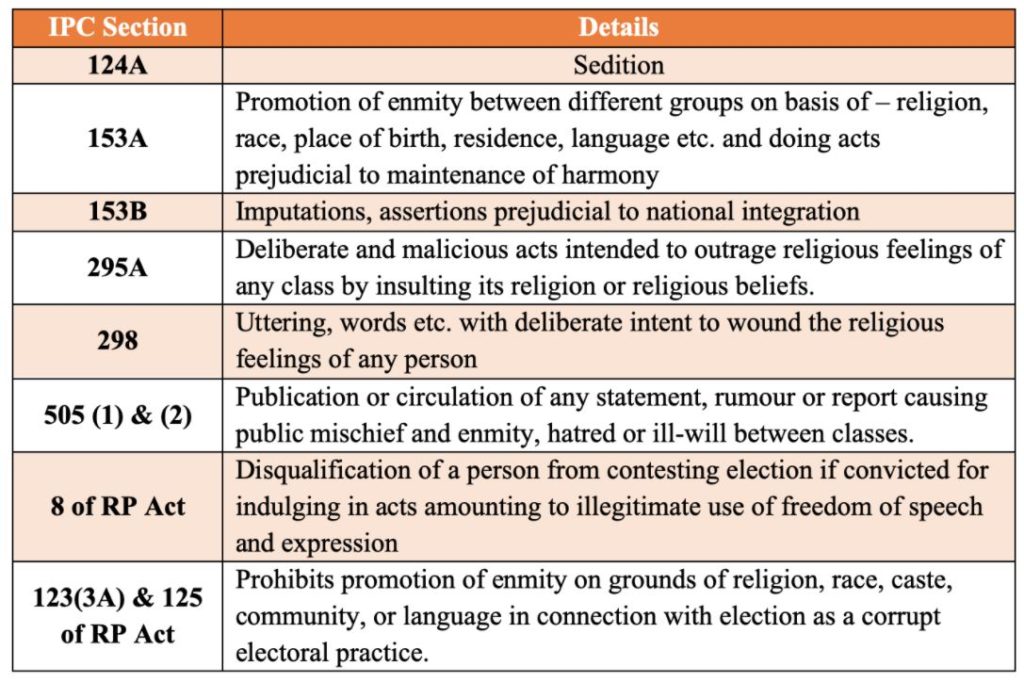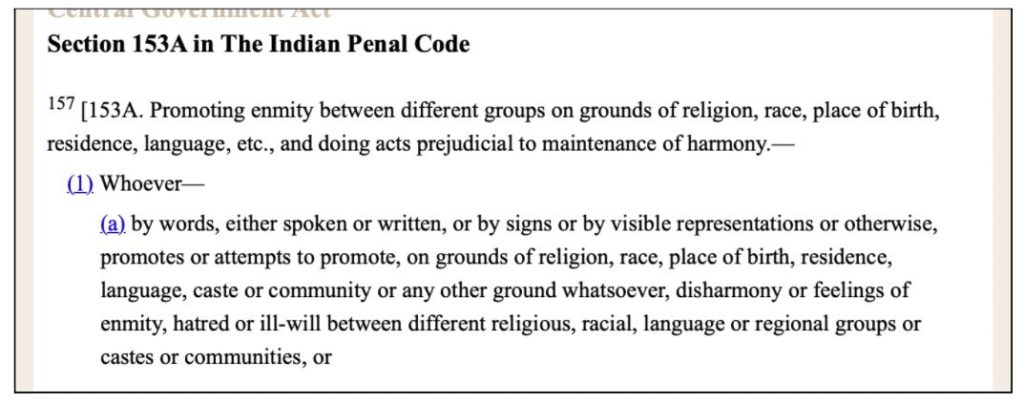‘Hate Speech’ is again at the centre of discussion thanks to some recent events. Data from the NCRB reports indicates that the number of cases registered under Section 153A & 153AA (for promoting enmity between groups) increased by more than four-fold between 2015 & 2020.
Video snippets from a recent ‘Dharam Sansad’ event in Haridwar were widely shared across social media, which showed some speakers making alleged hate speech, with some of them calling for violence against Muslims. The police filed an FIR under Section 153A in this regard. This along with a few other incidents of hate speech across the spectrum have once again brought to the fore the discussion around ‘Hate Speech’ and the laws relating to inciting hate against communities.
As the police file cases and the investigation is on, we look at the laws surrounding hate speech and the trends in the incidence and disposal of cases relating to hate speech over the years.
In the first of the two-part series, we review the legal framework of Hate speech in India and the trend in cases registered under the relevant sections of the Indian Penal Code (IPC).
Jurisprudential rationale to restrict free speech in case of Hate speech
In a lecture by Dr. Justice B.S. Chauhan, former judge of the Supreme Court of India, hate speech is among the 6 categories where Jurisprudential rationale can be exercised to restrict Free speech. This lecture was published in the Bureau of Police Research and Development (BPRD)’s The Indian Police Journal (April-June 2014).
The Constitution of India and legal procedures have provided measures to ensure the right to free speech to its citizens, which is key to a functioning democracy. Article 19(1)(A) of the Constitution of India ensures Freedom of Speech and Expression. However, under Article 19(2), incitement to offence is one of the grounds for legislative interference.
Some of the recent incidents include speeches that call for incitement to offence against a particular community and hence cannot be considered as Freedom of Speech and Expression.
As observed in the case of Pravasi Bhalai Sangathan vs Union of India & Ors:

However, there isn’t any legal or connotational definition for Hate speech in India and continues to remain an area of debate and interpretation. The Law Commission of India’s report on hate speech in 2017, provides other examples where the courts looked into the scope of hate speech.
The Law Commission of India in its 2017 report identified criteria that can be used to determine Hate speech. Factly’s story on this report can be read here.
Legal provisions in India relating to Hate speech
As highlighted earlier, there is no specific law in India that defines Hate Speech. However, there are certain legal provisions and legislations that prohibit select forms of speech as exceptions to freedom of speech.
The IPC has specific sections which deal with provisions that are exceptions to freedom of speech and relate to hate speech.

Apart from the IPC, other sections enshrined under – Representation of the People Act, 1951, Religious Institutions (Prevention of Misuse) Act, 1988, The Cable Television Network Regulation Act, 1995, etc. among others are also related to hate speech. s
Among these sections, Section 153A specifically deals with promoting enmity between the groups.

The National Crime Record Bureau’s annual Crime in India (CII) report provides details of the cases booked under IPC Sections 153A & I53AA and the disposal of the same by the police and the courts.
In this story, we look at the trend in the incidence of crime under these two sections of the IPC, the data of which is provided in the CII reports. It ought to be noted that as per the methodology followed by NCRB for the CII report, the data is based on the number of incidents that led to the registration of the crime & filing of a ‘First Information Report (FIR)’. This does not necessarily reflect the actual number of incidents that might have occurred. In addition, the NCRB follows the ‘Principal Offence Rule’ for the classification of crime. As per this rule, among many offences registered in a single FIR case, only the most heinous crime (maximum punishment) will be considered as a counting unit. Hence, some IPC crimes including under Sec 153 may be underreported.
Four-fold increase in the number of cases registered under Section 153A
In recent years, there is a considerable increase in the number of cases registered under Section 153A & 153AA i.e., ‘Promoting Enmity between groups’. The NCRB’s CII report provides data under this head since 2014. In that year, 336 cases were registered across the country under this section which increased to 378 in 2015. The number of cases increased consistently over the years except for 2019.
In 2017, there was a nearly two-fold increase in the number of cases registered under Section 153A with 934 cases compared to 447 in 2016. In 2019, the number of cases registered was 1058, slightly less than in 2018 when 1076 cases were registered.
The greatest number of cases in a year were registered in 2020 with 1804 cases, an increase of 70% compared to 2019. During the five-year period of 2015-2020, there is a more than four-fold increase in the number of cases registered under this section.
Tamil Nadu & Uttar Pradesh reported the most cases under Section 153A in 2020
The greatest number of cases under Section 153A & 153AA were registered in Tamil Nadu with 303 cases, followed by Uttar Pradesh at 243 in the year 2020. Both these states reported a sharp increase in the number of cases registered during 2020, compared to the year 2019 contributing to an overall increase in the number of cases during 2020.
Similarly, Telangana has also registered a sizeable increase in the number of cases during 2020.
Andhra Pradesh also registered an increase in the number of cases, but only slightly. Most of the other States with a higher number of cases under Section 153A during 2020, also reported a considerable increase in the number of cases compared to 2019. Kerala is an exception where the number of cases in 2020 reduced compared to 2019.
In the next story, we take a detailed look at disposal of cases registered under Section 153A by the police and the courts.


